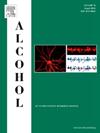Bidirectional relationships between daily sleep and alcohol use
IF 2.9
4区 医学
Q3 PHARMACOLOGY & PHARMACY
引用次数: 0
Abstract
Background
Prior longitudinal studies demonstrate that sleep disturbance is a risk factor for alcohol misuse. Experimental research also shows that alcohol intake negatively impacts sleep. The present study evaluated temporal bidirectional relationships between sleep and alcohol intake using intensive longitudinal methods.
Methods
57 college students (71 % female, Mage 24.1) participated in a two-week study assessing their daily sleep and alcohol use. Participants wore an actiwatch and completed daily diaries about their sleep and alcohol intake. Multi-level zero-inflated negative binomial models assessed whether prior sleep predicted next-day alcohol use. Linear multi-level models assessed whether alcohol use predicted daily sleep. All models assessed both within- (daily) and between-subject (average) effects because daily variations in sleep could influence alcohol use separately from average patterns and vice versa. Race, age, and sex were controlled in the analyses.
Results
Greater average wake after sleep onset (WASO) and sleep onset latency (SOL) and shorter daily total sleep time (TST) predicted greater next-day alcohol intake (WASO IR: 1.009; SOL IR: 1.011; TST IR: 0.998; p < .05). Higher average alcohol intake predicted increased daily WASO (B = 8.944, SE = 4.551, p < .05), TST (B = 12.717, SE = 5.877, p < .05), and decreased daily restedness (B = −0.158, SE = 0.064, p < .05).
Conclusions
These results highlight a dynamic bidirectional relationship between sleep and alcohol use. Findings suggest that average sleep and alcohol use patterns may be more meaningful to target than a single instance of poor sleep or excessive alcohol use.
每日睡眠与饮酒之间的双向关系
背景:先前的纵向研究表明,睡眠障碍是酒精滥用的一个危险因素。实验研究还表明,饮酒对睡眠有负面影响。本研究使用密集的纵向方法评估了睡眠和酒精摄入之间的时间双向关系。方法:57名大学生(71%为女性,年龄24.1岁)参加了一项为期两周的研究,评估他们的日常睡眠和酒精使用情况。参与者佩戴活动手表,并完成关于睡眠和酒精摄入量的每日日记。多级零膨胀负二项模型评估了睡眠是否能预测第二天的饮酒情况。线性多级模型评估了饮酒是否能预测日常睡眠。所有模型都评估了受试者内部(每日)和受试者之间(平均)的影响,因为每天睡眠的变化可能会影响酒精的使用,而不是平均模式,反之亦然。在分析中控制了种族、年龄和性别。结果:更大的平均醒后睡眠(WASO)和睡眠发作潜伏期(SOL)和更短的每日总睡眠时间(TST)预示着更大的第二天酒精摄入量(WASO IR: 1.009; SOL IR: 1.011; TST IR: 0.998; p < 0.05)。较高的平均酒精摄入量预测每日WASO (B = 8.944, SE = 4.551, p < 0.05)、TST (B = 12.717, SE = 5.877, p < 0.05)和每日静息度降低(B = -0.158, SE = 0.064, p < 0.05)。结论:这些结果强调了睡眠和饮酒之间的动态双向关系。研究结果表明,平均睡眠和酒精使用模式可能比单个睡眠不良或过度饮酒的实例更有意义。
本文章由计算机程序翻译,如有差异,请以英文原文为准。
求助全文
约1分钟内获得全文
求助全文
来源期刊

Alcohol
医学-毒理学
CiteScore
4.60
自引率
4.30%
发文量
74
审稿时长
15.6 weeks
期刊介绍:
Alcohol is an international, peer-reviewed journal that is devoted to publishing multi-disciplinary biomedical research on all aspects of the actions or effects of alcohol on the nervous system or on other organ systems. Emphasis is given to studies into the causes and consequences of alcohol abuse and alcoholism, and biomedical aspects of diagnosis, etiology, treatment or prevention of alcohol-related health effects.
Intended for both research scientists and practicing clinicians, the journal publishes original research on the neurobiological, neurobehavioral, and pathophysiological processes associated with alcohol drinking, alcohol abuse, alcohol-seeking behavior, tolerance, dependence, withdrawal, protracted abstinence, and relapse. In addition, the journal reports studies on the effects alcohol on brain mechanisms of neuroplasticity over the life span, biological factors associated with adolescent alcohol abuse, pharmacotherapeutic strategies in the treatment of alcoholism, biological and biochemical markers of alcohol abuse and alcoholism, pathological effects of uncontrolled drinking, biomedical and molecular factors in the effects on liver, immune system, and other organ systems, and biomedical aspects of fetal alcohol spectrum disorder including mechanisms of damage, diagnosis and early detection, treatment, and prevention. Articles are published from all levels of biomedical inquiry, including the following: molecular and cellular studies of alcohol''s actions in vitro and in vivo; animal model studies of genetic, pharmacological, behavioral, developmental or pathophysiological aspects of alcohol; human studies of genetic, behavioral, cognitive, neuroimaging, or pathological aspects of alcohol drinking; clinical studies of diagnosis (including dual diagnosis), treatment, prevention, and epidemiology. The journal will publish 9 issues per year; the accepted abbreviation for Alcohol for bibliographic citation is Alcohol.
 求助内容:
求助内容: 应助结果提醒方式:
应助结果提醒方式:


